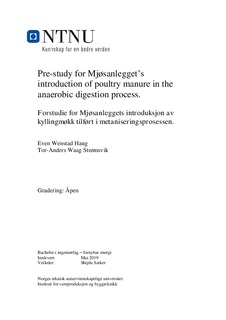| dc.description.abstract | Bakgrunn: Mjøsanlegget produserer gjødsel til bruk i gårdsdrift og biogass som brukes i lokale søppelbiler og busser i Oslo. Dette gjøres ved gjenvinning av søppel og kumøkk fra partnere i regionen. Mjøsanlegget har som intensjon å introdusere møkk fra fjærkre i biogassprosessen i håp om økt utbytte og kapasitet til å utnytte lokalt produsert møkk.
Metode: Studien samler vitenskapelige artikler relatert til metanisering av møkk fra fjærkre, sam-metanisering av møkk fra ku og fjærkre og prosesser for kontroll av ammoniakkproduksjon ved metanisering av møkk fra fjærkre. Dette vil gi Mjøsanlegget kunnskap til å kunne vurdere mulighetene for introduksjon av møkk fra fjærkre og utfordringer som dette kan medbringe. I tillegg er økningen i metanproduksjon fra de vitenskapelige artiklene inkludert som referanse til forskjell i produksjon.
Resultater: Sam-metanisering av møkk fra fjærkre med avfall fra agrikultur med høyt karboninnhold har resultert i senket produksjon av ammoniakk, noe som gir en bedre forhold mellom karbon og nitrogen. Dette fører til mindre hemning av metanisering og økt utbytte av metan. I likhet med dette har bruk av kumøkk som inokulasjonsmateriale med mais og møkk fra fjærkre som substrat demonstrert økning i metanproduksjon med en faktor på 1.2.
To-stegs metanisering med bruk av en membran som fjerning av ammoniakk har vist resultater der konsentrasjonen av ammoniakk er redusert helt ned til 2 g/kg i løpet av en periode på 21 timer. Bruk av ammoniakkstripping via gassgjenbruk har demonstrert reduksjoner i ammoniakkonsentrasjoner så høye som 82%.
Konklusjon: På grunn av økningen i stabilitet og metanutbytte, både gjennom sam-metanisering mellom møkk fra ku og fjærkre og sam-metanisering av kumøkk og avfall fra agrikultur, anbefaler studien en kombinasjon av de to metodene. Dette er for både å stabilisere og maksimere utbyttet av prosessen. I tillegg vil det medføre at få og små endringer i konfigurasjonen ved dagens anlegg, men fortsatt utføre den ønskede endringen i råstoff. Ammoniakkstripping og to-stegs før-hydrolyse med en membran ekstraktor anbefales videre studert med grunnlag i fordelen de kan ha ved å kunne utføre metanisering uten bruk av kumøkk, senket risiko for hemning av metaniseringen og nødvendige endringer i råtnetankene. | |
| dc.description.abstract | Background: Mjøsanlegget produces farm fertilizer for its surrounding regions and biogas for local garbage trucks and Oslo’s busses; utilizing municipal solid waste and cattle manure from their partnered regions. Their intent is to introduce poultry manure into their process configuration with the hopes of increasing methane yield and expanding their capability of utilizing different locally produced manures.
Method: The study gathers scientific studies related to anaerobic digestion of poultry manure, co-digestion of poultry manure, and ammonia controlling processes used in poultry manure digestion. This enables the study to provide the necessary knowledge for Mjøsanlegget to assess their possibilities for introducing poultry manure, be prepared for the possible challenges of doing so, and knowing means to deal with said challenges. Additionally, the increase in methane yield in the studies are included for a referential difference in production, noting that any small-scale experiment will only serve as a relative suggestion for expected change.
Results: Co-digestion of poultry manure with agricultural wastes high in carbon content has shown to decrease ammonia production to a more beneficial carbon to nitrogen ratio, resulting in less methanogenic inhibition and higher methane yields. Likewise, the usage of cattle manure for inoculum and maize and poultry manure for substrate has demonstrated large increases in methane yield up to 1.2-fold increases.
Two-stage digestion using a membrane contractor with ammonia extraction has shown ammonia levels decreasing to concentrations as low as 2 g/kg over the period of 21 hours, and ammonia stripping via gas recycle has demonstrated reductions of ammonia concentrations as high as 82%.
Conclusion: Due to the demonstrated increases in stability and methane yield in both co-digesting cattle and poultry manure, and co-digesting cattle manure with agricultural wastes, the study recommends a combination of the two methods to both stabilize and maximize the yield of the process; presenting a very small change in configuration from the current process, but accomplishing the wanted feedstock change. Ammonia stripping and two-stage pre-hydrolysis with a membrane extractor are recommended further studies due to their applicability of enabling digestion without cattle manure without risks of ammonia inhibition, but necessity for equipment changes in the digesters. | |
